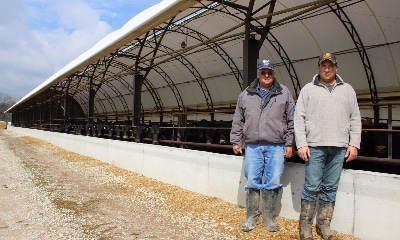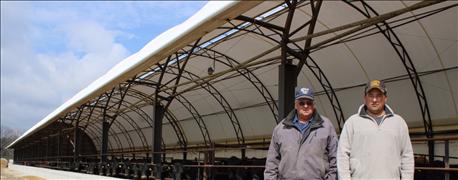
George Wassmann is not a superstitious man. Well, until that one Friday the 13th back in 2013. Construction just wrapped on a new hoop barn and the building was ready for its first group of feeder calves. "I was not going to jinx it," he recalls. "I said we either put those calves in Thursday or we wait until Saturday."
So, Thursday, Dec. 12, 2013, the calves entered the hoop beef building near Boonville.
George was looking for a means to keep his sons engaged in the family farming operation, which consists of a 300-cow herd and grain and hay ground. He spent time feeding stocker cattle, but decided to finish his own calves.
The benefits

LOOKING AHEAD: George Wassmann (right) found a hoop building allowed his son Danny to return to the farm.
The greatest benefit to the covered hoop system is it takes weather almost completely out of the equation, according to Danny Wassmann, George's son who returned to the farm full-time in 2011. "This allows us to take the weather off their back," he says. Without the extremes of heat and cold found in Missouri, the cattle are putting on more pounds in less time under roof. "We have seen a 15% boost in feed efficiency," Danny says. "We are able to finish them earlier and with less feed." He is finding the family uses 1/3 less feed to finish inside the barn rather than in their previous outside lots.
The cattle are fed according to pen. Just last month, the father-son duo was feeding three different rations for the calves in building. "It helps us dial in our nutrition needs for each group," Danny notes. "We want to get the most out of these calves with the least expense."
Nothing goes to waste at the farm. Manure from the barn is proving to be a benefit to pasture and hay ground. "There is a visual difference in the grass color of the pasture acres where we apply the manure from the barn," George explains. But more importantly, he notes, "Hay tonnage up."
~~~PAGE_BREAK_HERE~~~
The building
The hoop beef building is 320 feet long and 36 feet wide with a 4-foot awning over the feed bunk. It has roughly 320 head of cattle capacity.
There are six 40-foot pens and one 80-foot pen. On average, each 40-foot pen holds up to 37 head with the larger 80-foot holding, for the most part, a greater number of the larger calves. "It can be more or less depending on age and size of cattle," George explains. "We base it on bunk space."
A 32-foot concrete pad that runs the length of the building accommodates access to the feed bunk and waters. The remaining area is a cornstalk or wheat straw bedded manure-pack that keeps calves clean and cool in the summer, while allowing them to remain warm in the winter. The Wassmanns use roughly 320 large round bales for bedding each year.
Adding to the comfort of the cattle is the ventilation system. George says the air movement in the building is surprising. "Even with the curtains closed on one side air will come underneath the tarp, up and over the cattle," he notes. "The open vent in the roof does not let the weather in, but still keeps the air moving. It is really neat."
The building can withstand straight-line winds of 90 mph and a snow load of 35 pounds per square foot, according to Jeff Windett, member service manager for Hoop Beef System. "It is designed and built to out weather the elements," he noted. The company now has 20 miles worth of buildings mainly in the Midwest.
"Cattlemen are realizing whether it is finishing cattle, raising replacement heifers or housing cow-calf pairs, eliminating the risk of weather is helping their bottom line," Windett adds.
The change
George and Danny admit it took three years of researching hoop structures before they decided to build their own. "We visited different operations to see how they worked and if they lasted," Danny said.
Now after three years of feeding cattle under roof, George can put his superstitions to rest. "The building has worked perfectly." He can think of only one thing he would change, "I would have built it bigger."
About the Author(s)
You May Also Like






